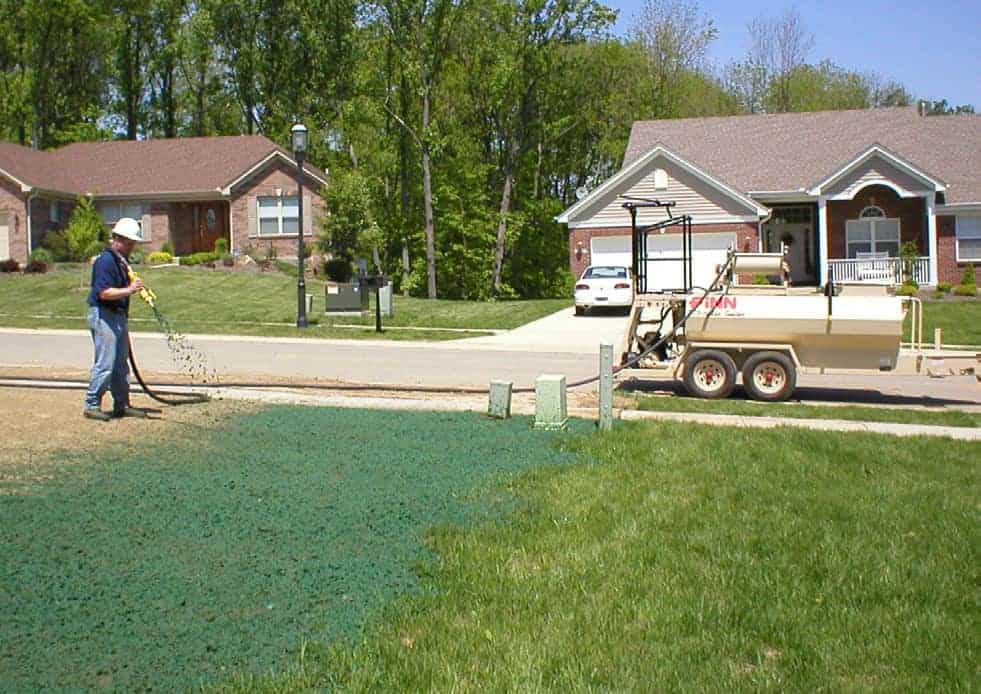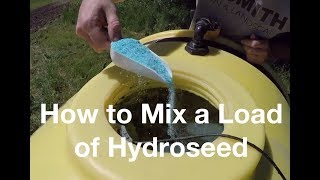To make a hydroseeding mix, combine grass seed, mulch, fertilizer, water, and a tackifier. Hydroseeding is a method used to plant grass by spraying a slurry mixture onto the ground, providing an efficient alternative to traditional seeding methods.
Hydroseeding is a popular and effective technique used to establish vegetation quickly on large areas of land. It involves spraying a mixture of grass seed, mulch, fertilizer, water, and a tackifier onto the soil. The mulch helps retain moisture, protects seeds from erosion, and promotes germination, while the fertilizer provides essential nutrients for growth.
The tackifier enhances adherence and helps the mixture stick to the soil, preventing runoff. This method is commonly used for erosion control, reclamation projects, lawn establishment, and even golf course construction. By using hydroseeding, you can achieve a lush green landscape in a shorter time frame compared to traditional seeding methods.

Credit: www.finncorp.com
How to Make Hydroseeding Mix: Step by Step Guide
Gathering The Ingredients
To make a hydroseeding mix, start by choosing the appropriate grass seed for your specific needs. Consider factors such as sun exposure, soil type, and climate. Next, select a suitable mulch material to provide protection and insulation for the seeds.
Common options include wood fiber, straw, or paper mulch. Additionally, prepare any necessary additives to promote seed germination and growth. These can include fertilizers, soil conditioners, and tackifiers to improve adhesion. Remember to follow the manufacturer’s instructions for proper mixing ratios.
It’s essential to carefully gather all the ingredients and ensure they are of high quality to achieve successful hydroseeding results. Take your time and make sure you have everything ready before starting the process.
Mixing The Hydroseeding Solution
Mixing the hydroseeding solution involves measuring the quantities of seed, mulch, and additives. Combine these ingredients in the hydroseeder, ensuring proper mixing and consistency. This crucial step sets the foundation for successful hydroseeding. By accurately measuring the components, you can achieve an optimal mix that promotes healthy seed germination and growth.
Make sure to use the right proportions for each ingredient, as this will directly impact the effectiveness of the hydroseeding process. Additionally, take care to thoroughly mix the solution to ensure a uniform distribution of the seed, mulch, and additives.
This will help to maximize coverage and improve overall results. Properly mixing the hydroseeding solution is key to achieving a beautiful and lush landscape.
Preparing The Application Area
To prepare the application area for hydroseeding, start by removing any debris and unwanted vegetation. Grade the soil properly to ensure optimal seed adhesion. If needed, conduct a soil test to determine its composition and any necessary amendments. This will help create a suitable environment for successful hydroseeding.
Applying The Hydroseeding Mix
The key to applying the hydroseeding mix is by setting up the hydroseeder equipment properly. Make sure to follow these steps carefully. After setting up, apply the mixture evenly and efficiently to ensure consistent coverage. This will help promote effective seed germination and growth.
Throughout the seeding process, it is important to oversee the progress closely. This allows you to make any necessary adjustments and achieve the best possible results. By following these guidelines, you can create a successful hydroseeding mix and achieve a lush and healthy lawn or landscape.
Post-Application Care
After the hydroseeding process, it is crucial to take proper care of the seeded area. One important aspect is watering. Maintaining the right amount of moisture is essential for seed germination and healthy growth. Regular monitoring and adjustment of the watering schedule is necessary to ensure that the seeds get adequate water without being oversaturated.
Keep a close eye on the weather conditions and adjust the watering frequency accordingly. Nurturing the germinated seeds is also essential. Avoid overwatering, as it can lead to shallow root growth. Instead, water the area deeply and allow the soil to dry slightly between watering sessions.
This will encourage deeper root growth and overall plant vigor. By providing proper post-application care, you can ensure the success of your hydroseeding efforts.
Maintenance And Troubleshooting
Hydroseeding mix maintenance and troubleshooting involve effective weed and pest control techniques. Addressing soil erosion issues is crucial, as well as dealing with common hydroseeding problems. Properly maintaining the hydroseeding mix helps ensure successful growth and germination. Regularly inspecting the area for pests and implementing appropriate control measures reduces their impact on the lawn.
Weed control techniques, such as hand pulling or using herbicides, should be employed to keep the area weed-free. Additionally, monitoring the soil erosion and sedimentation levels helps prevent future issues. Fixing common hydroseeding problems, like poor seed-to-soil contact or inadequate watering, promotes healthy growth and establishment.
By following these maintenance and troubleshooting practices, the hydroseeding mix will yield a lush, vibrant lawn.
Frequently Asked Questions For How To Make Hydroseeding Mix
How Do You Make A Hydroseeding Mix?
To make a hydroseeding mix, you will need a combination of grass seeds, mulch, fertilizer, tackifiers, and water. Mix the seeds, mulch, and fertilizer in a hydroseeding machine, and add water to achieve the desired consistency. Use tackifiers to help the mixture stick to the soil during application.
What Are The Benefits Of Hydroseeding?
Hydroseeding offers several benefits. It helps promote faster and more even seed germination, reduces erosion, and improves soil health. The mulch in the hydroseeding mixture helps retain moisture and protects seeds from birds and other external factors. Additionally, hydroseeding is cost-effective and can cover large areas quickly.
When Is The Best Time To Hydroseed?
The best time to hydroseed depends on the climate and the type of grass you are using. Generally, early fall or spring, when the temperature is moderate, and there is enough moisture in the soil, is the ideal time for hydroseeding.
This allows the grass seeds to establish root systems before extreme weather conditions occur.
Conclusion
Creating a hydroseeding mix is a simple yet effective method for establishing a lush and vibrant lawn or garden. By carefully selecting the right ingredients, such as grass seed, fertilizer, mulch, and tackifiers, you can ensure the success of your hydroseeding project.
Mixing these components in the correct ratios will provide the necessary nutrients and protection for the seeds to sprout and thrive. Remember to follow the manufacturer’s instructions and adjust the mix based on your specific requirements. Regular watering and maintenance will also contribute to the growth and health of your hydroseeded area.
So, whether you’re a homeowner or a landscaper, hydroseeding can be an efficient and cost-effective way to achieve a beautiful and resilient landscape. Start experimenting with your own hydroseeding mix today and enjoy the benefits of a lush and vibrant outdoor space.

